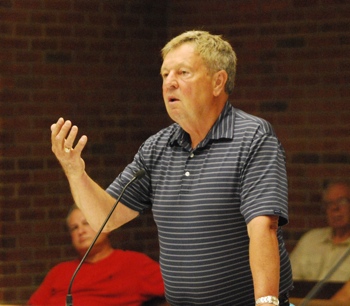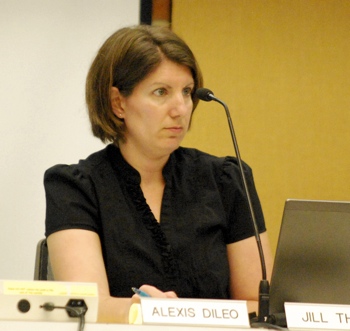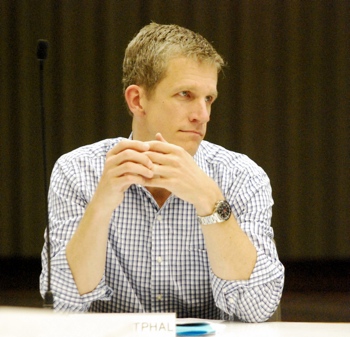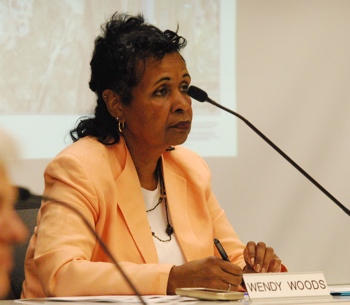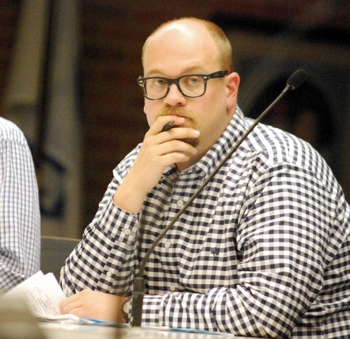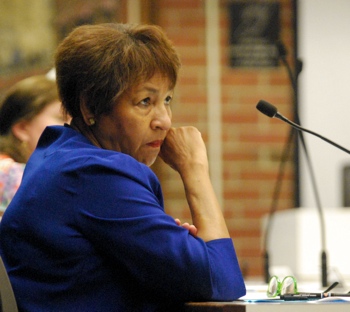New Wellness Center In The Works
Ann Arbor planning commission meeting (Aug. 19, 2014): Action taken by planning commissioners at its mid-August meeting will allow two projects to move forward: a new “modern lifestyle health spa” on West Liberty; and a new location for the Community Music School of Ann Arbor.

Jackie and John Farah address the Ann Arbor planning commission at its Aug. 19, 2014 meeting. To the right is Andrew Walters of Metro Consulting Associates, who’s working on the Farahs’ project. (Photos by the writer.)
Both projects required approval of a special exception use from the commission, because the zoning doesn’t allow those uses without it.
It was the health spa/fitness center proposal that drew the most scrutiny from commissioners. John and Jackie Farah want to convert part of an existing office building at 3100 W. Liberty into a facility that would provide personalized training and guidance to help people develop healthier lifestyles. Jackie Farah stressed that the focus is on wellness, not on athletic fitness. The center would be in the same complex as John Farah’s dental practice.
Six people spoke during a public hearing on this project, including the Farahs as well as nearby residents. Concerns from neighbors included the disturbances that additional use of this site would have on their properties. Also speaking against the project was Brian Eisner, owner of the nearby Liberty Athletic Club, who expressed concern about increased traffic on West Liberty. The Farahs stressed that their effort would not increase traffic or negatively impact the residential neighbors.
During deliberations, commissioners considered putting limits on the hours of operation or restricting use to appointments only, but ultimately rejected those constraints. However, they did amend the special exception use to limit the amount of square footage that could be used for fitness center activities – to 9,000 square feet. It does not require additional city council approval.
The other special exception use was granted to the Community Music School of Ann Arbor, allowing it to operate at 1289 Jewett Ave., between South Industrial and Packard. The music school will share the building of Clonlara School, a private K-12 educational institution.
Commissioners also recommended the annexation and zoning of 2115 Victoria Circle, a half-acre vacant site west of Newport and north of M-14. If approved by the city council, the property would be annexed from Ann Arbor Township and zoned R1A (single family dwelling).
Farah Fitness Center
The Aug. 19 agenda included a request for a special exception use to create a fitness center at 3100 W. Liberty.
The proposal by the owners, John and Jackie Farah, is to convert part of an existing office building on the southern end of a 5.37-acre site into a fitness center that would operate similar to a physical therapy/rehabilitation facility, according to a staff report. The special exception use allows for indoor recreation on a site zoned office (O). It would be part of the Farah Professional Center, which was first developed in 1995 and expanded in 2005.
The site – on the north side of West Liberty, between Wagner and South Maple – includes a 13,000-square foot, two-story building and a 10,000-square foot, one-story building with an 89-space parking lot. The two-story building includes John Farah’s dental practice. The one-story building houses a dental consulting firm and a milling center for dentists and dental labs nationwide. The property is located in Ward 5.
The staff report stated that the proposed center “is a facility available to customers by appointment only, offering less than a dozen pieces of equipment such as treadmills, elliptical, bikes and nautilus machines. Yoga, spinning, massage therapy and acupuncture also will be offered. Hours of operation will be consistent with normal office/health practitioner business hours.” [.pdf of staff report]
The office zoning district is intended as a transition between residential areas and other types of uses that would be incompatible with neighborhoods. In addition to offices – including medical and dental – the office-zoned sites can include salons, funeral homes, artist studios, hotels, and private colleges. With a special exception use, the sites can include veterinarian hospitals and kennels, and indoor recreation.
Separately, the owners have submitted an administrative amendment to the previously approved site plan for changes to the office center’s parking lot. The proposal is to increase the number of spaces from 89 to 104 within the limits of the current parking area. The additional spaces are required to support the proposed indoor recreation use. The modified parking lot would have 70 full-sized spaces, 29 compact-sized spaces, and 5 barrier-free spaces. Of those 104 spaces, 12 would be “deferred” – meaning they will be shown on the planning documents, but not installed.
The administrative amendment does not require planning commission or city council approval. Nor is additional council approval required for the special exception use.
Staff recommended approval.
Farah Fitness Center: Public Hearing
Six people spoke during a public hearing on this project, including the Farahs as well as nearby residents. Some of them had also submitted letters to the commission.
Ira Mark told commissioners that he’s a resident of the adjacent subdivision, and lives on Trego Circle. “This building is literally in my back yard.” Almost 19 years ago, he addressed the commission with other neighbors who negotiated significantly with John Farah about the first building that was constructed. He said at that time, the neighbors were guaranteed that the development would have certain hours of operation. Over the years, he’s spent thousands of dollars on landscaping and blackout shades. His neighbors have done the same, Mark said. They still hear cars and see lights from the development.
He indicated that it’s good that the parking won’t be expanded. He hoped that any additional lighting would be minimized. He said he took offense at the Farahs’ statement that the hours of operation won’t be detrimental to the neighborhood. Sometimes there are runners in the parking lot at 5 a.m. – he can hear them talk about where they’ll be running. If the new facility is by appointment only, can people make appointments for 10 o’clock at night or 5 in the morning? Even now, sometimes there are lights on in the building after regular business hours, he said.
Mark said that Farah has been willing to talk to neighbors when they’ve had issues over the years, and those issues have been resolved. He gave the example of trash pickup that used to be done in the early morning. But if there’s a lot of traffic in the parking lot at odd hours, it will be disturbing, he said, and it would potentially impact his property value. [.pdf of Mark's letter]
Brian Eisner introduced himself as the owner of the nearby Liberty Athletic Club – it’s located on the opposite side of West Liberty, in Scio Township. His major concern was traffic. There’s already a problem along that section of West Liberty, he said, citing two very serious accidents in recent years. It’s almost impossible to make a left turn onto West Liberty from the south side, during certain times of the day. His business has been there for 40 years, and he’s seen the traffic pattern change.
Eisner said he knows how many people come to a fitness center, because he owns one. The Liberty Athletic Club has yoga classes with 40 people enrolled, “so these are not small numbers,” he said. The Farahs’ whole business model has been disguised, he said, and he’d like to know what the business model really is. He suggested that the planning commission restrict the number of people that could be in the building at any one time. “I’m just very, very leery about the very, very sketchy information that we have, and how that’s going to impact a serious, serious problem,” he said, referring to traffic. He said he represented the concerns of his club’s members as well. [.pdf of Eisner's letter]
Bill Moorhead, another nearby resident, said his concerns were similar to those stated by Mark and Eisner. He thought that the operation needed to be defined. Is it a spa, or athletic club, or rehabilitation facility? [.pdf of Moorhead's letter]
Andrew Walters of Metro Consulting Associates was attending on behalf of the Farahs, who were also at the meeting. The proposal is for a “modern lifestyle health spa,” he said. It would provide a combination of services that deal with maintaining a healthy lifestyle. The use is consistent with some of the other uses that are allowed without a special exception use, he said, such as health practitioner or beauty salons that provide massage. There is, however, an athletic component to their proposal, Walters added, and that’s what triggered the need for a special exception use.
No parking expansion is proposed, Walters noted. New spaces will be added by re-striping the existing parking lot. Nor is there planned expansion of the parking lot lighting, he said. Ultimately, it will just be a change in tenant of the building, and it won’t be a hindrance to the neighborhood. All the uses will be indoors, and the hours of operation will mostly be during general business hours – 8 a.m. to 7 p.m. Regarding traffic, the site currently has office and medical/dental office uses, he said. A health fitness club use would be expected to produce the same or less traffic than a medical/dental office, he said. The people who visit would be spread out during the day, not all at the start and end of the business day.
The Farahs also addressed the commission. John Farah said he’s lived in Ann Arbor over 50 years. He’s a runner and believes in fitness. The proposal is to really help people lead a healthy lifestyle, he said. Many of his friends who are his age aren’t in as good of shape as he is, Farah said. “I think I have ways of helping people in the community.”
The place will be limited in size and will be very personalized, Farah told commissioners. He said that Ira Mark knows that any time the neighbors had a problem, he would address it. “I hate to say this,” Farah added, talking to Mark, “but you have never seen any runners in that lot. We have never had anybody congregating there in that lot.”
Before this space became empty, the previous tenants employed up to 22 people at one point, Farah reported. “We will not employ any more than three or four people in that area.” It should not affect the traffic in any detrimental way.
Farah noted that he’s been a member of the Liberty Athletic Club for many years, and he appreciates it. He’s taken many yoga classes there, and there have never been 40 people in a class. Usually the size is 12-15 people, except on Sundays when there are up to 25. That club also has only ??23 bikes in the spinning room, he noted.
Farah said he’s contributed to this community in many ways, and he thinks this new project will benefit the community too.
Farah then introduced his wife, Jackie Farah. There are many interpretations of the word “fitness,” she noted. But their focus is on the healthy lifestyle aspect, “and not fitness in a gym where you work out to become a better athlete.” Their spinning room will have eight bicycles. There will be one private yoga room for one or two people, she said, and the other yoga room will fit 12 people. “We’re really trying to zoom in on a very personal fitness plan for people,” she said. They’re proud of trying to help people, including those who’ve finished physical therapy or are fighting debilitating illness and need to continue with yoga or other instruction. The focus is on wellness, not on being a better athlete, she concluded.
Farah Fitness Center: Commission Discussion
Kirk Westphal wondered whether the description of the operation that’s included in the staff report would be tied to the special exception use – that is, would the special exception use only be valid as long as the fitness center reflects what’s described in the report? For example, the report states that the center will have less than a dozen pieces of equipment. What if the center eventually has two dozen pieces?
City planner Alexis DiLeo replied that the special exception use would be for an “indoor fitness center.” There are no limitations as to size or hours or maximum membership, she said, and the special exception use would apply to the entire site. However, it could be amended by commissioners to stipulate a limit on square footage, for example, or to put a limit on hours, she said.
Westphal wondered if city code for this zoning district puts any limit on hours of operation. No, DiLeo replied. There are city code limits on construction hours, but for not general business or retail hours.
Westphal also clarified with DiLeo that the special exception use would stay with the parcel, not the owner. “It’s not like a functional family,” she noted – a reference to a controversial request by local Jesuits for a function family special exception use earlier this summer.
Sabra Briere asked about the proposed use for the adjacent property that’s located in Scio Township. DiLeo replied that it’s owned by the Washtenaw County office of the water resources commissioner, and is part of the Sister Lakes drain. It’s open space, she said.
Briere ventured that the land creates a buffer between the residents on Trego Circle and the Farahs’ site. How wide is that buffer? DiLeo said she’d check to be sure, but she thought it was around 100 feet. Andrew Walters of Metro Consulting Associates reported that it’s at least 35 feet wide.
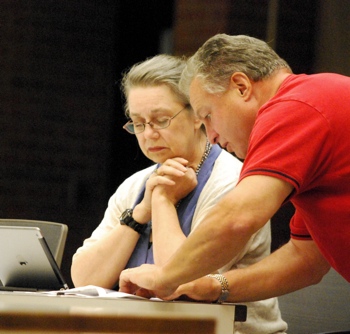
Ira Mark gives some information to Sabra Briere, who serves as the city council’s representative on the planning commission. Mark raised concerns about a proposed fitness center near his property off of West Liberty.
Bonnie Bona pointed out that in addition to the drain property, there’s also a landscape buffer for the parking lot. DiLeo said that it’s a conflicting land use buffer, so it should be a minimum of 15 feet. She added that some additional landscaping is being put in, as part of the redesign of the parking lot, in order to meet the city’s current square-footage requirement for a “vehicular use area.” DiLeo explained how the redesign was being handled. Walters reported that three trees are being added to the landscaping, mostly on the eastern side of the site – nearest to the residential area.
Eleanore Adenekan asked about the hours of operation, confirming with John Farah that it would be from 8 a.m. to 7 p.m. Farah said they haven’t worked out details about whether there would be weekend activity. It might be necessary to be there a few hours, to accommodate the schedules of certain individuals. He doubted they would do anything on Sundays.
Jeremy Peters asked whether the fitness center would take up the entire building – if not, how much space would be used? Farah replied that the building is two floors. His dental clinic is on the second floor, so the center would be on the first floor, with about 6,400 square feet.
Replying to another query from Peters, Farah said there would be trainers available to work with clients by appointment.
Bona commended the Farahs, saying that they’re proposing a great business, so her comments weren’t a critique of their business plan. “Creativity and keeping people healthy is all a good thing – it’s whether or not it’s appropriate in this location,” she said.
Bona said she’s struggling with the use of an indoor fitness center. What zoning district would allow for a more traditional fitness club, like Liberty Athletic Club? DiLeo replied that the bulk of the city’s zoning ordinance was developed in the 1960s, and terms like “gym” and “yoga” are not included. The ordinance does mention indoor recreation – for court games like raquetball, which were popular at that time.
But the ordinance has to be interpreted for modern times, DiLeo said. So the staff has interpreted and applied the ordinance to allow for a gym or fitness use on sites that are zoned as commercial districts, as well as in other zoning districts – office and light manufacturing – that allow for indoor recreation as a special exception use.
Wendy Woods asked what entity is responsible for West Liberty Street? Briere responded that the road is actually in Scio Township. DiLeo noted that the road is under the purview of the Washtenaw County road commission.
No traffic study is required for this project, DiLeo explained. A study is triggered only if the Institute of Traffic Engineers manual indicates that a site’s use will generate more than 50 trips in a peak hour, she said. Based on this project’s square footage and type of use, it fell below that amount.
Bona said the concerns she’s heard relate to hours of operation, traffic, lighting, and the amount of parking. The principal uses that are allowed in an office district – such as beauty salons, institutions of higher education, hotels, health practitioners – vary widely in their hours of operation, she noted. The district allows for a lot more flexibility than what perhaps the neighbors would like, she said.
Bona added that she was struggling to figure out how the Farahs’ proposed use was different from a health practitioner. She wondered why a special exception was needed in the first place, and it didn’t make sense to limit the hours of operation when some of the other allowed uses would have even longer hours.
Diane Giannola said she saw things a bit differently. In a commercial area, there are more comings and goings during the day. For an office area – including a medical center – there would be less coming and going, she said, because people would primarily be entering and exiting at the beginning and end of the work day. So a commercial fitness center would have much more traffic than an office, she said.
Giannola’s concern with this item was that the special exception use would be attached to the property. The Farahs’ project appears to be appointment-only, she noted, which would limit the number of people coming into the site. She suggested amending the special exception use so that it would be limited to appointment-only centers. That would limit it for future uses too, so that businesses like Curves wouldn’t be allowed to operate there.
Responding to a query from Briere, John Farah said the dental consulting firm and milling center combined employ about two dozen people, who work during standard business hours. The same is true for employees of his dental office, though in that case there are also patients who arrive and depart throughout the day. Briere noted that in a way, the fitness center would be like adding dental patients, because they’d have scheduled appointments.
Farah thought the flow of people to the fitness center would be much lower than for his dental office. Walters added that the fitness center wouldn’t be adding to peak-hour traffic.
Briere pointed out that the entire site won’t be used for one purpose, but it will continue to be used for multiple purposes. She agreed with Bona, saying she’s hard-pressed to see why this fitness center requires a special exception use. She suggested it might be time to revisit the city code, since it’s so outdated.
Bona clarified that her intent isn’t to change the rules, but rather to define businesses that exist today that are consistent with those already allowed. “We’re not talking about allowing things that would have characteristics dramatically different from what’s already allowed,” she said.
Westphal wanted to make sure commissioners all understood what would be allowed under this special exception use, which applies to the whole site. The lot hasn’t been developed as much as it could be, he noted, so if the property changed hands, this special exception use could allow for a significantly expanded fitness center, like a Planet Fitness. He didn’t doubt that the Farahs planned a smaller operation, but he wanted to be clear that in the future, something like a large gym would be a possibility.
DiLeo noted that the staff typically recommends some kind of quantity limit on any special exception use. For example, a special exception use for veterinary kennels would typically limit the number of dogs. Most schools come with a maximum number of students. So perhaps in this case, she said, it would make sense to limit the square footage allowed for a fitness center.
Westphal said he’d be open to that, as well as to some kind of “generous” limit on hours of operation.
Peters supported a limit on square footage, and also suggested limiting the usage to appointments only. That might address at least some of the traffic concerns, he said.
Bona said she’d like to see this business operate at this location. Regarding the suggestion on limiting use to appointments only, she noted that this zoning district allows institutions of higher education – without a special exception use. Such institutions hold classes, she observed, and those are often held in the evening. “It’s a little odd to put restrictions on a use when some of the allowed primary uses can do more,” Bona said.
However, Bona added that in the interest of allowing this to move forward, the appointment limitation and square footage are reasonable, “especially since it looks like we need to have a more robust discussion about how we define primary use.” She suggested that if revisions to the city code are made, the district shouldn’t be called “office” if there are a lot of non-office uses that are allowed. It misleads the neighbors into making certain assumptions about what could be located there, she said.
Giannola asked whether Farah intended to sell unlimited-use passes for the facility.
Farah responded by saying he was trying to be creative with this project, and to accommodate people in various ways. “I mean, how many restrictions can you put, you know?” Farah asked.
They’ve thought about whether to offer classes or a lecture to small groups, on topics like nutrition. They’ll probably experiment with different ideas, he said. But in general, it would be geared toward very small numbers of people. That makes it different from places like Liberty Athletic Club, he said.
Regarding limits on hours of operation, Farah said they want to cater to individuals – so occasionally, someone might need to be there until 8 p.m. He didn’t think it made sense to put time limitations. Giannola replied that it’s not a concern with his business, but if he sold the building, someone else could put in a different operation. “I’m not selling the building,” Farah said.
Giannola noted that in 10 or 20 years, that might change. The city can’t take back a special exception use, if all of the requirements are being met, she noted. So that’s why commissioners are being cautious.
Based on the discussion, Westphal said he’d withdraw his suggestion to limit the hours. He also questioned the enforceability of restricting the use to appointments only. However, he’d continue to support a limit on square footage.
Peters proposed amending the special exception use to limit it to 9,000 square feet.
Outcome on amendment: It passed unanimously on a voice vote.
There was no further discussion.
Outcome on amended special exception use: It passed unanimously and does not require additional approval from city council.
Community Music School
The planning commission was asked to grant a special exception use to the Community Music School of Ann Arbor to operate at 1289 Jewett Ave., between South Industrial and Packard. It would allow the private music school to use the Clonlara School building with a maximum of 150 students at any time.
Clonlara School, a private K-12 institution, is located in a district zoned R1B (single family dwelling), which permits private schools if given a special exception use approval. Most of the surrounding properties are single-family homes or duplexes. Clonlara already has a special exception use to operate with a maximum of 150 students. No changes are planned for the exterior of Clonlara’s 16,900-square-foot, single-story building.
The music school will primarily use the facility on weekdays from 3:30-9 p.m., on Saturdays from 9 a.m. to 6 p.m., and on occasional Sunday afternoons. Over the last three years, the music school has enrolled 220-250 students, but on an average day, only about 25-30 students come in for lessons.
Even if there were an overlap in classes between Clonlara and the music school, there could only be a total of 150 students in the building at the same time.
Clonlara School’s 2.46-acre site includes 22 parking spaces in a parking lot off Jewett Avenue, plus three spaces behind a rental house located north of the school building. A one-way drive runs north from Jewett to Rosewood Street.
The city’s traffic engineer reviewed this request and thought that the number of instructors and students on that site at any given time would have a negligible traffic impact. Jill Thacher of the city’s planning staff reported that there’s good public transportation access to that location, with a bus stop near the corner of Jewett and South Industrial, and other nearby stops on Packard. [.pdf of staff report]
Thacher said she’d received two calls from neighbors about this request, both of them inquiring about how loud the music would be. Clonlara windows don’t open, she noted, so that helps to contain sound. “They don’t intend to hold lessons outdoors on the site,” she added.
Community Music School: Public Hearing
Two people spoke during the public hearing, both in support of the special exception use.

Kasia Bielak-Hoops, executive director of the Community Music School (formerly the Ann Arbor School for the Performing Arts).
Kasia Bielak-Hoops, executive director of the Community Music School (formerly the Ann Arbor School for the Performing Arts), explained why the school would like to move to Clonlara. “We feel that it is an incredible capacity-building opportunity for us,” she said, and also an opportunity to collaborate with a similar organization.
The music school’s activities will not disturb the peace of the neighborhood, she said, and it might even be a resource to the community. She quoted from an email she’d received from a resident who lives on Jewett. The resident described the move as a “win-win” for the neighborhood, enlivening it with kids and families. Maybe some nearby residents would even sign up for classes.
Bielak-Hoops said she’d be happy to answer any questions that commissioners might have.
Martha Rhodes, Clonlara’s campus director, also described the compatibility of the two schools and their focus on lifelong learning. Clonlara has worked hard to become a “green” school, she said, and this change would continue that effort – because it would bring more activity to a large building that sits empty after 3:30 p.m. and on weekends.
The music school also offers the opportunity for deeper programming for Clonlara’s students, Rhodes said, “and an opportunity for both programs to grow together.” She hoped the commission would see it as a really good use of empty space, and would approve the special exception use.
Community Music School: Commission Discussion
Diane Giannola asked why the music school needed a special exception use, since there’s already an active special exception use for a school at that location.
Jill Thacher replied that music schools are considered to be different “because they make more noise than elementary schools,” though she joked that as someone with experience at elementary schools, she might challenge that assumption.
Jeremy Peters noted that he works in the music industry and has a degree in music, so he joked that his question will probably cause his friends to yell at him. He wondered if the school was planning to hold lessons for amplified instruments.
Kasia Bielak-Hoops replied that they do offer a jazz studies program that includes electric guitar. They also have a guitar teacher who gives lessons in both acoustic and electric guitar. “But the plan is to have it indoors,” she said.
Peters cautioned that the music school should be aware of possible concerns from neighbors over noise. He said it didn’t seem like that would be an issue, but he wanted to raise it since the city had heard from residents about it.
Responding to comments made during the public hearing, Kirk Westphal noted that the planning commission does like to see buildings used longer and parking lots filled more times during the day.
Outcome: Commissioners unanimously granted the special exception use for the Community Music School.
Victoria Circle Annexation
The Aug. 19 agenda included a resolution to recommend the annexation and zoning of 2115 Victoria Circle, a half-acre vacant site west of Newport and north of M-14.
If approved by the city council, the property would be annexed from Ann Arbor Township and zoned R1A (single family dwelling).
The owner, Abayomi Famurewa, wants to build a single-family home there and connect to the city’s public water and sanitary sewer service. The staff report notes that the city’s storm sewer system does not extend to that area at this point. [.pdf of staff report] Staff had recommended approval.
No one spoke during a public hearing on this item.
Victoria Circle Annexation: Commission Discussion
Sabra Briere noted that the city has recently annexed several properties on Victoria Circle. Homeowners in the adjacent neighborhood have concerns that driveways would lead onto Newport Creek or one of the nearby streets. She pointed out that the property under consideration looks like it could have a driveway onto Newport Creek. Briere wondered if the city has any restrictions on that type of thing.
City planner Alexis DiLeo replied that Newport Creek is a public street, and the number of curbcuts permitted for any particular property is based on the property’s frontage onto a road. She noted that the property didn’t actually connect to Newport Creek. She didn’t believe the 2115 Victoria Circle site had enough frontage to warrant two curbcuts on Victoria Circle.
Bonnie Bona observed that the property has public land on one side (the Riverwood Nature Area), as well as sites zoned for single-family dwelling (R1A) and two vacant lots zoned as planned unit developments (PUDs). She asked about the history of the PUDs. DiLeo replied those sites zoned PUD are city-owned parkland, though she could not recall why they were still zoned PUD. She explained that the sites are “virtually undevelopable,” because it would require a voter referendum to sell parkland.
Kirk Westphal asked if the city-owned PUD sites were used as cut-throughs to the nature area, and whether the property owner of 2115 Victoria Circle knew that people might use it for that purpose. DiLeo said she wasn’t sure on either count. Briere ventured that there’s not currently a trailhead at that location into the nature area. DiLeo replied that staff could mention it in the letter that would be sent to the owner after annexation is approved.
Outcome: Commissioners unanimously recommended approval of the annexation and zoning. The item will be forwarded to city council for consideration.
Present: Eleanore Adenekan, Bonnie Bona, Sabra Briere, Diane Giannola, Kirk Westphal, Wendy Woods, Jeremy Peters.
Absent: Ken Clein.
Next meeting: Wednesday, Sept. 3, 2014 at 7 p.m. in council chambers at city hall, 301 E. Huron. [Check Chronicle event listings to confirm date.]






